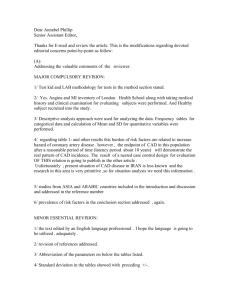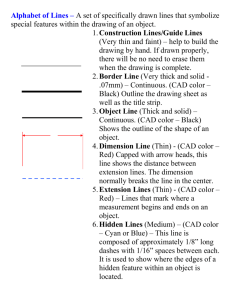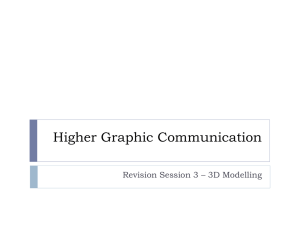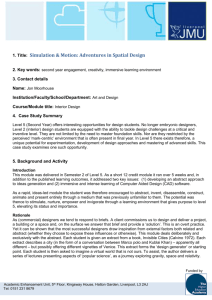WEB SERVICES IN ARCHITECTURAL AND CIVIL ENGINEERING
advertisement
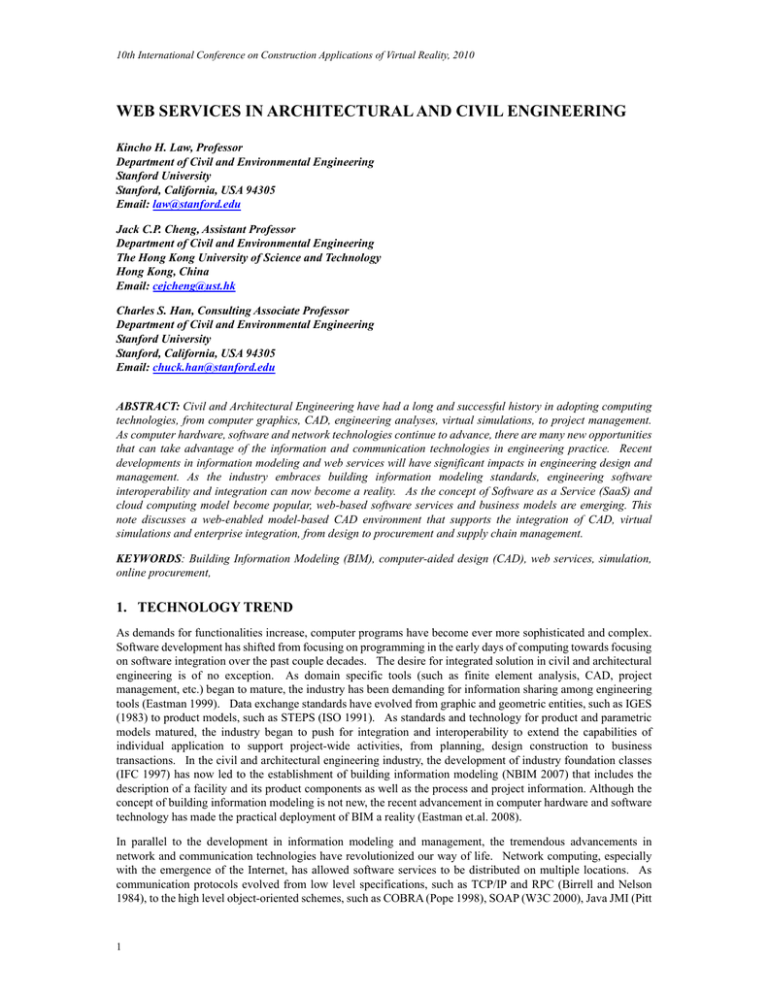
10th International Conference on Construction Applications of Virtual Reality, 2010 WEB SERVICES IN ARCHITECTURAL AND CIVIL ENGINEERING Kincho H. Law, Professor Department of Civil and Environmental Engineering Stanford University Stanford, California, USA 94305 Email: law@stanford.edu Jack C.P. Cheng, Assistant Professor Department of Civil and Environmental Engineering The Hong Kong University of Science and Technology Hong Kong, China Email: cejcheng@ust.hk Charles S. Han, Consulting Associate Professor Department of Civil and Environmental Engineering Stanford University Stanford, California, USA 94305 Email: chuck.han@stanford.edu ABSTRACT: Civil and Architectural Engineering have had a long and successful history in adopting computing technologies, from computer graphics, CAD, engineering analyses, virtual simulations, to project management. As computer hardware, software and network technologies continue to advance, there are many new opportunities that can take advantage of the information and communication technologies in engineering practice. Recent developments in information modeling and web services will have significant impacts in engineering design and management. As the industry embraces building information modeling standards, engineering software interoperability and integration can now become a reality. As the concept of Software as a Service (SaaS) and cloud computing model become popular, web-based software services and business models are emerging. This note discusses a web-enabled model-based CAD environment that supports the integration of CAD, virtual simulations and enterprise integration, from design to procurement and supply chain management. KEYWORDS: Building Information Modeling (BIM), computer-aided design (CAD), web services, simulation, online procurement, 1. TECHNOLOGY TREND As demands for functionalities increase, computer programs have become ever more sophisticated and complex. Software development has shifted from focusing on programming in the early days of computing towards focusing on software integration over the past couple decades. The desire for integrated solution in civil and architectural engineering is of no exception. As domain specific tools (such as finite element analysis, CAD, project management, etc.) began to mature, the industry has been demanding for information sharing among engineering tools (Eastman 1999). Data exchange standards have evolved from graphic and geometric entities, such as IGES (1983) to product models, such as STEPS (ISO 1991). As standards and technology for product and parametric models matured, the industry began to push for integration and interoperability to extend the capabilities of individual application to support project-wide activities, from planning, design construction to business transactions. In the civil and architectural engineering industry, the development of industry foundation classes (IFC 1997) has now led to the establishment of building information modeling (NBIM 2007) that includes the description of a facility and its product components as well as the process and project information. Although the concept of building information modeling is not new, the recent advancement in computer hardware and software technology has made the practical deployment of BIM a reality (Eastman et.al. 2008). In parallel to the development in information modeling and management, the tremendous advancements in network and communication technologies have revolutionized our way of life. Network computing, especially with the emergence of the Internet, has allowed software services to be distributed on multiple locations. As communication protocols evolved from low level specifications, such as TCP/IP and RPC (Birrell and Nelson 1984), to the high level object-oriented schemes, such as COBRA (Pope 1998), SOAP (W3C 2000), Java JMI (Pitt 1 Nov. 4-5, 2010 and McNiff 2001), implementation of distributed services has been greatly facilitated. The computing environment has been transformed from stand-alone desktop applications to an interconnected web of autonomous services accessible inside and outside the boundary of an organization. A web service can be described generally as a specific function that is delivered over the internet to perform a service or to provide a specific information. Web-based information standards, such as XML (Young 2001), RDF (Brickley and Guha 1998), and OWL (Dean et.al. 2002), and web-based description languages, such as WSDL (W3C 2004) and BPEL4WS (Andrews et.al. 2003) have been developed to facilitate the description, reuse and integration of web services. The web service model has become a favorite approach for integrating software applications and extending the functionalities of an application by making it interoperable with other services. An engineering simulation can now involve a number of geographically distributed software applications. Online information can be dynamically integrated with an application. The Internet infrastructure can be leveraged to support interoperation between applications and collaboration between organizations. 2. WEB-ENABLED MODEL-BASED CAD ENVIRONMENT Computer Aided Design (CAD), since its inception, has been widely used in facility design and construction. A web-enabled CAD environment could facilitate collaboration and enhance communication between designers and other stakeholders. As the Internet becomes ubiquitously accessible, a web-enabled CAD system can be extended to interact with online information and to integrate web services within the CAD application. As BIM standards continue to enrich the description of a facility, the information embedded in the CAD model can be used not only for design but also support design analysis, project management and other functions. The National Building Information Modeling Standard defines a BIM as “a computable representation of all the physical and functional characteristics of a building and its related project/lifecycle information” for the building owner/operator to use and maintain throughout the lifecycle of a building (NBIM 2007). A model-based CAD environment refers to an information-rich CAD platform that embraces the BIM concept and includes not only the geometry information of a CAD object but also the information that supports the activities involving the objects and their relationships with the other objects (Cheng et.al. 2010). By enabling a model-based CAD to interact with the web environment, users can query, incorporate and integrate online information and/or services within the CAD systems, therefore extending the scopes and functionalities of the CAD system. Plug-in software can be built to render a CAD tool web-enabled. One example is the plug-in software, SpecifiCAD (see http://www.cadalytic.com), that can dynamically match user-defined building product content with online data such as the Google 3D Warehouse and other vendors. As illustrated in Figure 1, when the user clicks on a component object (say, a window in the Sketchup model), the tool displays the pre-defined object attributes, such as the product ID, supplier name, etc.. When the user switches to the catalogue module, the tool searches the online catalogues and displays similar products from partnering suppliers. The user can interactively replace the CAD component object with a selected product displayed on the search result page. By capturing the information about the component objects, the model-based CAD application can be linked to simulation tools for performance analysis. Figure 2 shows an example of linking the Sketchup tool with the Integrated Environmental Solutions software (see http://www.iesve.com/) for energy and carbon emission analysis. Different design configurations, constructed using different online products, can be evaluated and compared (see Figure 3). With the building information stored in the database and linked to the web-enabled model-based CAD environment, project management and business transactions (such as procurement, scheduling and supply chain) can be integrated directly with a CAD application tool (Cheng 2009). 3. DISCUSSION With the maturation of CAD and information modeling standards and Internet technologies, the vision of an Internet-based, or a web-enabled, CAD environment (Han et.al 1998, 1999) can now be fully realized. As the concept of Software as a Service (SaaS) and cloud computing become popular, web-based software services and business models will continue to emerge (Mell and Grance 2009, Kumar and Cheng 2010). This note discussed some of the potential benefits for a web-enabled model-based CAD environment that takes full advantage of the recent developments in building information modeling and web service technologies. 2 10th International Conference on Construction Applications of Virtual Reality, 2010 Dynamic catalog Catalog Product Information Schedule Product Information - Anderson (5) - EML Hardware (6) - Excellence (6) Product ID: “3 A NE Window” Supplier: Petom Contact person: George Kim (kim@petom.com) Product name: 200 Series Tilt-Wash Double-Hung Windows Model number: WIN-200-DHL Material: MetalGlass Color: Price: 350.0 Anderson Contact: Jack Cheng (cpcheng@stanford.edu) Product: 200 Series Tilt-Wash Double-Hung Windows Price: $278.0 Description: 2’11-1/2” W x 4’8-1/2” H Anderson Contact: Jack Cheng (cpcheng@stanford.edu) Product: 400 Series Tilt-Wash Double-Hung Windows Price: $398.0 Description: 3’1-5/8” W x 5’9-5/8” H Architectural drawing [Google Sketchup] Figure 1: Web-enabled interactive tool in Google Sketchup leveraging the technology of SpecifiCAD IES Virtual Environment Room properties Component information Totally 8 rooms Room 8 Room type definition Heating Cooling Lights Equipment Total 43% 7% 13% 37% 54.85 MBtu/yr Areas (ft2) of floor, wall, and glazed areas Figure 2: Energy and carbon emission analysis of a building (a) Original model (b) Double glazed windows replaced with triple glazed ones (d) Windows on the sides and at the back are removed Energy Heating Cooling Lights Equipment Total (MBtu/yr) (a) 23.6 43% 3.8 7% 7.1 13% 20.3 37% 54.8 100% (c) Replaced with larger windows (b) 23.3 46% 1.6 3% 7.3 14% 18.6 37% 50.8 100% (c) 23.9 41% 5.8 10% 7.0 12% 21.6 37% 58.3 100% (d) 23.1 44% 2.1 4% 7.8 15% 19.4 37% 52.4 100% Figure 3: Evaluation and comparison of different architectural design alternatives in terms of energy use 3 Nov. 4-5, 2010 4. ACKNOWLEDGMENT This work is partially supported by the US National Science Foundation, Grant No. CMS-0601167 and the Enterprise Systems Group at the US National Institute of Standards and Technology (NIST). Any opinions and findings are those of the authors, and do not necessarily reflect the views of NSF or NIST. No approval or endorsement of any commercial product by NIST, NSF or Stanford University is intended or implied. 5. REFERENCES Andrews, T., et.al. (2003), Specification: Business Process Execution Language for Web Services (BPEL4WS), Version 1.1., http://www-106.ibm.com/developerworks/library/ws-bpel/. Birrell AD, and Nelson BJ. (1984), “Implementing Remote Procedure Calls,” ACM Transactions on Computer Systems. 2(1):39-59. Brickley, D. and Guha, R.V., (1999) (editors), Resource Description Framework (RDF) Schema Specification, World Wide Web Consortium. (available at http://www.w3.org/TR/1998/WD-rdf-schema). Cheng, J.C.P., (2009) SC Collaborator: A Service Oriented Framework for Construction Supply Chain Collaboration and Monitoring, Ph.D. Thesis, Dept. of Civil and Env. Engrg., Stanford University, Stanford, CA. Cheng, J.C.P., Law, K.H., Zhang, Y. and Han, C.S. (2010), “Web-Enabled Model-Based CAD for the Architectural, Engineering and Construction Industry,” 1st Int. Conference on Sustainable Urbanization, Hong Kong. Dean, M. et.al. (2002), Web Ontology Language (OWL) Reference, Version 1.0, W3C Organization, (available at http://www.w3.org/TR/2002/WD-owl-ref-20021. Eastman, C.,M., (1999), Building Product Models, CRC Press. Eastman, C., Teicholz, P., Sacks, R., and Liston, K. (2008). BIM Handbook: A Guide to Building Information Modeling for Owners, Managers, Designers, Engineers and Contractors, Wiley. Han, C.S., Kunz, J.C., and Law, K.H. (1998), “Internet-Based Computer-Aided Design: Leveraging Product Model, Distributed Object, and World Wide Web Standards.” Structural Congress ASCE. San Francisco, CA. Han, C. S., Kunz, J. C. and Law, K. H. (1999). "Building Design Services in a Distributed Service Architecture." Journal Computing in Civil Engineering, 13(1), 12-22. IFC (1997), Industry Foundation Classes, Release 1.0, Int. Alliance for Interoperability, Washington, D.C.. IGES (1983), Initial Graphics Exchange Specification, National Bureau of Standards, Version 2. ISO (1991), DIS 10303, Product Data Representation and Exchange, ISO, TC184/SC4. Kumar, B. and Cheng, J.C.P. (2010), "Cloud Computing and Its Implications for Construction IT," Int. Computing Conf. on Civil and Building Engineering (ICCCBE XIII), Nottingham, UK. Mell, P. and Grance, T. (2009), The NIST Definition of Cloud Computing, Version 15, 10-7-09 (available at http:// csrc.nist.gov/groups/SNS/cloud-computing/cloud-def-v15.doc). NBIM (2007), National Building Information Modeling Standard Part-1: Overview, Principles and Methodologies, National Institute of Building Sciences (available at http://www.wbdg.org/bim/nbims.php). Pitt E, and McNiff K.(2001), Java(tm).RMI: The Remote Method Invocation Guide, Addison-Wesley. Pope A. (1998), The CORBA Reference Guide, Addison-Wesley. W3C (2000), Simple Object Access Protocol (SOAP), version 1.1, World Wide Web Consortium. W3C (2004), Web Services Description Language (WSDL), version 2.0, World Wide Web Consortium. Young, M.J. (2001), Step by Step XML, Microsoft Press. 4


